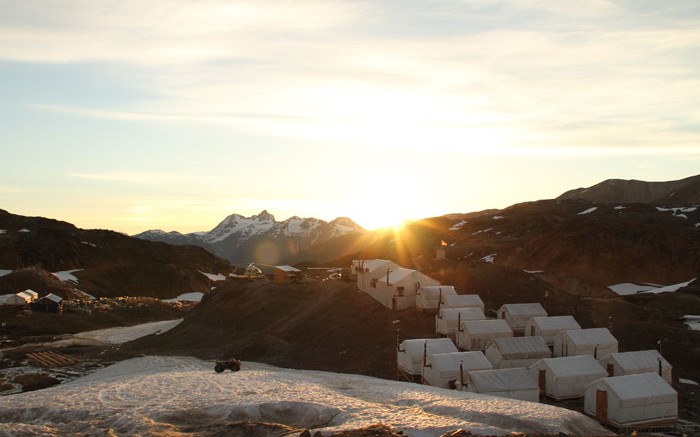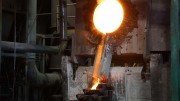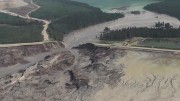The Pretium saga brings to mind the old joke about the ever-optimistic geologist seeing that the glass is half full, while the mining engineer sees only that the glass should be reduced in size by 50%.
In 2010, Pretium had its initial public offering at $6 and bought its flagship Brucejack gold-silver project in remote, northwestern B.C. from Silver Standard for a cool $450 million in cash and shares.
Since then, the Vancouver-based junior, led by veteran geologist and former Silver Standard exec Robert Quartermain (Qvartermain?), has pushed the project forward at breakneck speed. It has so far brought drilling in the Valley of the Kings deposit to 200,000 metres; defined a probable reserve of 6.6 million oz. gold in 15.1 million tonnes grading 13.6 grams gold; completed a feasibility study showing potential to mine 321,500 oz. gold annually over a 22-year mine life, starting in 2016; and picked up the prestigious Bill Dennis discovery award from the Prospectors & Developers Association of Canada.
And after all that frenzied activity, Pretium’s market capitalization is only $323 million today, or 28% less than the Brucejack purchase price, and its shares are 47% below the IPO price.
What the heck happened?
Hopefully our extended interview with Quartermain in this issue will provide some insight. But the short answer lies with consulting firm Strathcona Mineral Services, and its highly respected co-founder and 2010 Canadian Mining Hall of Fame inductee, mining engineer Graham Farquharson.
On Oct. 8 Strathcona took the bold step of withdrawing as a secondary consultant on what has been one of the world’s most high-profile gold exploration “success” stories. In response, Pretium shares — which approached $18 in early 2012 — plunged from $7 to below $5, wiping out $235 million in market value.
At that time, when reached by reporters, Farquharson would not comment and pretty much dared Pretium to reveal the reasons Strathcona had given Pretium for the sudden exit.
To Pretium’s credit, they did just that in the end, and there are a couple of doozies in Pretium’s Oct. 22 release that quote Strathcona as saying that “there are no valid gold mineral resources for the VOK zone, and without mineral resources there can be no mineral reserves, and without mineral reserves there can be no basis for a feasibility study.” And further: “statements included in all recent press releases [by Pretium] about probable mineral reserves and future gold production [from the Valley of the Kings zone] over a 22-year mine life are erroneous and misleading.”
As the young people would say: “Boom!”
This is a devastating assessment from one of the most highly regarded consulting firms in Canada, headed by an individual with a sterling reputation for sobriety and competence. Of course, we weren’t the only ones to see that: Pretium’s stock has further plunged to $3.16, erasing another $145 million of market cap.
Quartermain and Pretium’s response to this has been to not deviate one iota from the existing development plan, and to stay on a strict message track with supporters and media — it’s a lot like listening to Mitt Romney in October 2012 talking about his complete confidence that he would win the next month’s U.S. presidential election, despite all the polls showing the contrary.
There’s been some muddying of the waters by Pretium, trying to cast the problem as a small dispute between consulting firms over which is a better method of sampling: Strathcona’s work with the sample tower, or Snowden’s work in compiling data from the 10,000-tonne bulk sample, but that’s beside the point. Of course the bulk sampling is better — it’s just a question of whether you can get almost-as-good results from the sample tower, which is cheaper.
A hint of what may be the problem is seen in Pretium and Snowden’s deliberate choice of an extremely high upper cap of 430 grams gold per tonne on drill assays. This goes against the industry’s rule of thumb of capping assays at 30 grams gold to diminish the nugget effect.
At least stylistically, Pretium’s overemphasis on high grade can be seen in the way it constantly promotes uncut, high-grade intercepts that are only 0.5 metre long, which are not meaningful in a bulk-mining setting — the mining method Pretium is proposing to use at the Valley of the Kings.
It’s tricky: Quartermain, Snowden and Farquharson’s Strathcona are all impressive and well-regarded in the industry, but Farquharson arguably has the greatest credibility of the three. On the other hand, Quartermain and Snowden know the deposit much better than Strathcona, and have the most to lose monetarily and credibility wise, if the reserve numbers and anticipated production numbers prove to be overstated.
There will be two big tells in the shorter term, however.
The first is the amount of gold in the 10,000-tonne bulk sample — Quartermain unequivocally says there will be more than 4,000 oz. gold.
The second is which third-party consultant Snowden and Pretium will hire to replace Strathcona in its sample tower work and to verify Snowden’s next resource update. If they can’t find a credible, brand-name consultant, that’s a sign that professional misgivings over the reserve estimate could be widespread in the consulting community, and that consultants want to avoid getting dragged into the class action lawsuits that would ensue if Brucejack comes apart at the seams.
[See Pretium’s response to this editorial here.]




Qvartermain… that’s fv–ing hilariovs!
Sounds like its time for a next generation version 43-102; and please cap high end gold values to 30g/t, this is relevant and prudent, but not neccessarily realistic. Credibility is key.
No kidding. I think that is the first time the NM has ever made me laugh!
Re: “…it’s just a question of whether you can get almost-as-good results from the sample tower, which is cheaper.”
In this case the question has an answer: For the results that have been publicly released, the sample tower underestimated the ore grade by about half. It would be a bit of a stretch to call that almost-as-good.
There is no valid reason to use a 30gr cut. It is used if, (a) you don’t know any better, or (b) haven’t aquired a sufficiently large population of values with which to statistically arrive at an appropriate cutting value. The cut value is calculated to leave a sufficiently small population of high grade above the cut. The pretium cut appears entirely appropriate for the kind of nugget-type environment hosting the VOK deposit.
I think people need to keep in mind that it was Strathcona that physically oversaw the mining of the 10,000-tonne bulk sample, which is a lot of rock. They drilled the rock, blasted it, mucked it, hauled it out, crushed it, and ran it through the sample tower. They were extremely close in a very real, tactile, physical sense to that 10,00 tonnes, which is theoretically extremely nuggety with gold visible to the naked eye. And maybe 6-7 weeks after doing this work, they quit the project. That should make anyone pause.
I was one of the first miners in that Mine when it reopened, I was one of the original 3 to re timber the portal at brucejack (NewHawk) so we can pump it out. from what we have heard from old miners and what we have seen as they miners from before left drilled off rounds, this gold is here and it is ready for the taking, its just in small veins not big ore bodies.
Brad